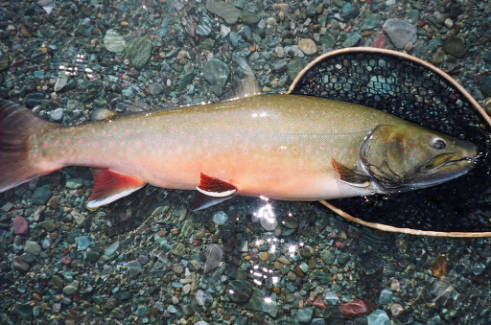|
Monday, January 4, 2016
Struggling Bull Trout Get a Defender in Pacific Northwest
WildEarth Guardians Threatens to Sue U.S. Forest Service for Failing to Address Threat From Motorized Use of Roads and Trails
Contact: Marla Nelson (651) 434-7737 mnelson@wildearthguardians.org
PORTLAND, OR – Bull trout face an uphill battle to recovery. Not only does the cold-water salmonid face impending climate change threats, but badly managed forest roads and trails dump dirt and sediment into its spawning areas. WildEarth Guardians warned the U.S. Forest Service in December about its failure to ensure protection for the bull trout in the Colville, Payette, and Sawtooth National Forests in Washington and Idaho.
Listed as threatened under the Endangered Species Act by the U.S. Fish and Wildlife Service in 1999, bull trout populations have been reduced to less than half of their historic range. Bull trout distribution has changed very little since the species was listed. This top-level predator is picky about its habitat—the fish require cold, clean, complex and connected habitat.
“Bull trout face tremendous challenges on their path to recovery as a species,” said Marla Nelson, Rewilding Attorney with WildEarth Guardians. “It’s extremely frustrating to see a federal agency like the Forest Service with a mandate to protect these fish—and the power to make a difference—failing to consider the ongoing impacts of its management decisions.”
 It comes as no surprise that threats to bull trout survival include habitat destruction, splintering of habitat into smaller pieces, obstacles such as culverts and roads blocking migratory fish passage, poor water quality, the effects of climate change, and poor management of fisheries in the past. What is surprising, however, is the U.S. Forest Service’s failure to ensure adequate protection of bull trout in the face of motorized use of roads and trails on public lands. It comes as no surprise that threats to bull trout survival include habitat destruction, splintering of habitat into smaller pieces, obstacles such as culverts and roads blocking migratory fish passage, poor water quality, the effects of climate change, and poor management of fisheries in the past. What is surprising, however, is the U.S. Forest Service’s failure to ensure adequate protection of bull trout in the face of motorized use of roads and trails on public lands.
In 2010, after years of legal and political wrangling, the Fish and Wildlife Service designated numerous streams in the Colville, Payette, and Sawtooth National Forests as bull trout critical habitat. At that point, the Forest Service had an obligation to ensure its decisions about motorized use of roads and trails were not likely to harm the newly designated critical habitat. Yet more than five years later they have failed to do so.
“Every inch counts in this struggle to recover bull trout populations,” said Nelson. “That is why it is so important that we hold the Forest Service accountable when it passes over a major opportunity to assure its decisions about motorized use on our National Forests adequately protect bull trout and bull trout critical habitat.”
Motorized use on roads and trails degrades watersheds over time by releasing dirt and other pollutants into forest streams. Young fish, still developing in spawning gravels, get smothered by the dirt. Sediment (dirt) can change the dimensions of streams, making them wider and deeper. In turn, this increases stream temperatures and can further harm fish like bull trout.
photo credit: public domain/ NCTC Image Library
|
|
|

 It comes as no surprise that threats to bull trout survival include habitat destruction, splintering of habitat into smaller pieces, obstacles such as culverts and roads blocking migratory fish passage, poor water quality, the effects of climate change, and poor management of fisheries in the past. What is surprising, however, is the U.S. Forest Service’s failure to ensure adequate protection of bull trout in the face of motorized use of roads and trails on public lands.
It comes as no surprise that threats to bull trout survival include habitat destruction, splintering of habitat into smaller pieces, obstacles such as culverts and roads blocking migratory fish passage, poor water quality, the effects of climate change, and poor management of fisheries in the past. What is surprising, however, is the U.S. Forest Service’s failure to ensure adequate protection of bull trout in the face of motorized use of roads and trails on public lands.